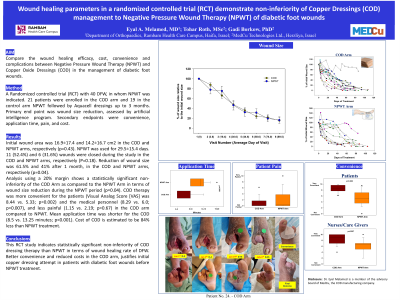Clinical Research
(CR-021) Preliminary results of wound healing parameters in a randomized controlled trial (RCT) demonstrate non-inferiority of Copper Dressings (COD) management to Negative Pressure Wound Therapy (NPWT) of diabetic foot wounds

Methods: Randomized controlled trial with 60 diabetic patients comparing quality and rate of wound healing by using an artificial intelligence program, cost of treatment, convenience to patient and caregiver and other adverse events during 3 months of COD management or NPWT.
Results:
A total of 40 patients finalized the study. 21 patients were enrolled in the COD arm and 19 in the NPWT arm. The mean and SD initial wound areas were 16.9±17.4 and 14.2±16.7 cm2 in the COD and NPWT arms, respectively (p=0.43). Eleven wounds (52.4%) and 6 wounds (31.6%) were closed during the 3 months of treatment in the COD and NPWT arms, respectively. Reduction of wound size was 61.5% and 41% (p=0.04) after 1 month, 80.9% and 69% (p=0.28) after 2 months, and 88% and 84% (p=0.17) after 3 months, in the COD and NPWT arms, respectively. Analysis using a 20% margin shows a statistically significant non-inferiority of the COD Arm as compared to the NPWT Arm in terms of wound size reduction. COD therapy was more convenient (Visual Analog Score [VAS] was 8.44 vs. 5.33; p=0.002) and less painful (VAS was 1.15 vs. 2.19; p=0.67) to the patients in the COD arm than in the NPWT arm. The medical personnel scored COD application as more convenient than the NPWT application (8.29 vs. 6; p=0.007). The mean application time was shorter for the COD compared to the NPWT (8.5 vs. 13.25 minutes; p< 0.001). Cost is estimated to be ~16% in the COD Arm compared to NPWT Arm.
Discussion: The preliminary results of this RCT study indicate statistically significant non-inferiority of COD dressing therapy than NPWT in terms of wound healing rate of DFU. However, there are several benefits of using the COD than NPWT, such as convenience and reduced costs, raising the possibility of using the COD instead of NPWT for management of diabetic foot wounds as the first line of treatment.
Trademarked Items:
References:

.png)